| Web
and Book design,
Copyright, Kellscraft Studio 1999-2010 (Return to Web Text-ures) |
Click
Here to return to
Japanese Homes and their Surroundings Content Page Return to the Previous Chapter |
 (HOME)
|
|
CHAPTER II.
TYPES OF HOUSES.
CITY
AND COUNTRY HOUSES. FISHERMEN'S HOUSES. KURA. A STUDY OF
ROOFS. SHINGLED ROOFS. TILED ROOFS. STONE ROOFS.
THATCHED ROOFS.
WRITERS on Japan have often commented upon the absence of any grand or imposing architectural edifices in that country; and they have offered in explanation, that in a country shaken by frequent earthquakes no stately structures or buildings of lofty proportions can endure. Nevertheless, many such structures do exist, and have existed for centuries, as witness the old temples and lofty pagodas, and also the castles of the Daimios, notably the ones at Kumamoto and Nagoya. If the truth were known, it would be found that revolution and rebellion have been among the principal destructive agencies in nearly obliterating whatever may have once existed of grand architectural structures in Japan. Aimé Humbert finds much to admire in the castles of the Daimios, and says, with truth: "In general, richness of detail is less aimed at than the general effect resulting from the grandeur and harmony of the proportions of the buildings. In this respect some of the seigniorial residences of Japan deserve to figure among the architectural monuments of Eastern Asia." In regard to the architecture of Japan, as to other matters, one must put himself in an attitude of sympathy with her people, or at least he must become awakened to a sympathetic appreciation of their work and the conditions under which it has arisen. Above all, he must rid himself of all preconceived ideas as to what a house should be, and judge the work of a Japanese builder solely from the Japanese stand-point. Architectural edifices, such as we recognize as architectural, do not exist outside her temples and castles. Some reason for this condition of things may be looked for in the fact that the vast majority of the Japanese are poor, very poor; and further, in the fact that the idea of co-operative buildings, with the exception of the yashiki barracks, has never entered a Japanese mind, each family, with few exceptions, managing to have a house of its own. As a result of this, a vast number of the houses are shelters merely, and are such from necessity; though even among these poorer shelters little bits of temple architecture creep in, quite as scanty, however, in that respect as are similar features in our two-storied wooden boxes at home, which may have a bit of Grecian suggestion in the window caps, or of Doric in the front door-posts. In considering the temples of the Japanese, moreover, one should take into account their methods of worship, and precisely what use the worshippers make of these remarkable edifices. And so with intelligent sympathy finally aroused in all these matters, they begin to wear a new aspect; and what appeared grotesque and unmeaning before, now becomes full of significance and beauty. We see that there is something truly majestic in the appearance of the broad and massive temples, with the grand upward sweep of their heavily-tiled roofs and deep-shaded eaves, with intricate maze of supports and carvings beneath; the whole sustained on colossal round posts locked and tied together by equally massive timbers. Certainly, to a Japanese the effect must be inspiring beyond description; and the contrast between these structures and the tiny and perishable dwellings that surround them renders the former all the more grand and impressive. Foreigners, though familiar with the cathedral architecture of Europe must yet see much to admire in these buildings. Even in the smaller towns and villages, where one might least expect to find such structures, the traveller sometimes encounters these stately edifices. Their surroundings are invariably picturesque; no sterile lot, or worthless sand-hill outside the village, will suit these simple people, but the most charming and beautiful place is always selected as a site for their temples of worship. Whatever may be said regarding the architecture of Japan, the foreigner, at least, finds it difficult to recognize any distinct types of architecture among the houses, or to distinguish any radical differences in the various kinds of dwellings he sees in his travels through the country. It may be possible that these exist, for one soon gets to recognize the differences between the ancient and modern house. There are also marked differences between the compact house of the merchant in the city and the country house; but as for special types of architecture that would parallel the different styles found in our country, there are none. Everywhere one notices minor details of finish and ornament which he sees more fully developed in the temple architecture, and which is evidently derived from this source; and if it can be shown, as it unquestionably can, that these features were brought into the country by the priests who brought one of the two great religions, then we can trace many features of architectural detail to their home, and to the avenues through which they came. In connection with the statement just made, that it is difficult to recognize any special types of architecture in Japanese dwellings, it may be interesting to mention that we found it impossible to get books in their language treating of house architecture. Doubtless books of this nature exist, indeed, they must exist; but though the writer had a Japanese bookseller, and a number of intelligent friends among the Japanese, looking for such books, he never had the good fortune to secure any. Books in abundance can be got treating of temple architecture, from the plans of the framing to the completed structure; also of kura, or go-downs, gateways, tori-i, etc. Plans of buildings for their tea-ceremonies, and endless designs for the inside finish of a house, the recesses, book-shelves, screens, and indeed all the delicate cabinet-work, are easily obtainable; but a book which shall show the plans and elevations of the ordinary dwelling the writer has never yet seen. A number of friends have given him the plans of their houses as made by the carpenter, but there were no elevations or details of outside finish represented. It would seem as if, for the ordinary houses at least, it were only necessary to detail in plan the number and size of the rooms, leaving the rest of the structure to be completed in any way by the carpenter, so long as he contrived to keep the rain out. If there is no attempt at architectural display in the dwelling-houses of Japan the traveller is at least spared those miserable experiences he so often encounters in his own country, where to a few houses of good taste he is sure to pass hundreds of perforated wooden boxes with angular roofs and red chimneys unrelieved by a single moulding; and now and then to meet with one of those cupola-crowned, broad-brimmed, corinthian-columned abominations, as well as with other forms equally grotesque and equally offending good taste. Owing to the former somewhat isolated life of the different provinces, the style of building in Japan varies considerably; and this is more particularly marked in the design of the roof and ridge. Though the Japanese are conservative in many things concerning the house, it is worthy of note that changes have taken place in the house architecture within two hundred and fifty years; at all events, houses of the olden times have much heavier beams in their frame and wider planks in their structure, than have the houses of more recent times. A probable reason is that wood was much cheaper in past times; or it is possible that experience has taught them that sufficiently strong houses can be made with lighter material. The Japanese dwellings are always of wood, usually of one story and unpainted. Rarely does a house strike one as being specially marked or better looking than its neighbors; more substantial, certainly, some of them are, and yet there is a sameness about them which becomes wearisome. Particularly is this the case with the long, uninteresting row of houses that border a village street; their picturesque roofs alone save them from becoming monotonous. A closer study, however, reveals some marked differences between the country and city houses, as well as between those of different provinces. The country house, if anything more than a shelter from the elements, is larger and more substantial than the city house, and with its ponderous thatched roof and elaborate ridge is always picturesque. One sees much larger houses in the north, roofs of grand proportions and an amplitude of space beneath, that farther south occurs only under the roofs of temples. We speak now of the houses of the better classes, for the poor farm-laborer and fisherman, as well as their prototypes in the city, possess houses that are little better than shanties, built, as a friend has forcibly expressed it, of "chips, paper, and straw." But even these huts, clustered together as they oftentimes are in the larger cities, are palatial in contrast to the shattered and filthy condition of a like class of tenements in many of the cities of Christian countries. In travelling through the country the absence of a middle class, as indicated by the dwellings, is painfully apparent. It is true that you pass, now and then, large comfortable houses with their broad thatched roofs, showing evidences of wealth and abundance in the numerous kura and outbuildings surrounding them; but where you find one of these you pass hundreds which are barely more than shelters for their inmates; and within, the few necessary articles render the evidences of poverty all the more apparent. Though the people that inhabit such shelters are very poor, they appear contented and cheerful notwithstanding their poverty. Other classes, who though not poverty-stricken are yet poor in every sense of the word, occupy dwellings of the simplest character. Many of the dwellings are often diminutive in size; and as one looks in at a tiny cottage containing two or three rooms at the most, the entire house hardly bigger than a good-sized room at home, and observes a family of three or four persons living quietly and in a cleanly manner in this limited space, he learns that in Japan, at least, poverty and constricted quarters are not always correlated with coarse manners, filth, and crime. Country and city houses of the better class vary as greatly as with us, the one with its ponderous thatched roof and smoke-blackened interior, the other with low roof neatly tiled, or shingled, and the perfection of cleanliness within. In Tokio, the houses that abut directly on the street have a close and prison-like aspect. The walls are composed of boards or plaster, and perforated with one or two small windows lightly barred with bamboo, or heavily barred with square wood-gratings. The entrance to one of these houses is generally at one corner, or at the side. The back of the house and one side, at least, have a verandah. I speak now of the better class of houses in the city, but not of the best houses, which almost invariably stand back from the street and are surrounded by gardens. The accompanying sketch (fig. 33) represents a group of houses bordering a street in Kanda Ku, Tokio. The windows are in some cases projecting or hanging bays, and are barred with bamboo or square bars of wood. A sliding-screen covered with stout white paper takes the place of our glass-windows. Through these gratings the inmates of the house do their bargaining with the street venders. The entrance to these houses is usually by means of a gate common to a number. This entrance consists of a large gate used for vehicles and heavy loads, and by the side of this is a smaller gate used by the people. Sometimes the big gate has a large square opening in it, closed by a sliding-door or grating, and through this the inmates have ingress and egress. 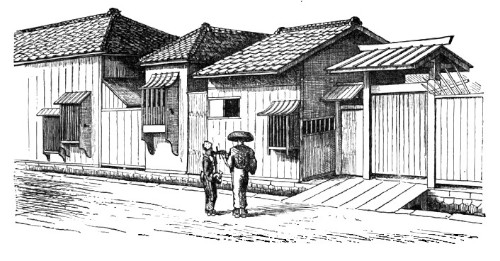 33. STREET IN KANDA KU, TOKIO The houses, if of wood, are painted black; or else, as is more usually the case, the wood is left in its natural state, and this gradually turns to a darker shade by exposure. When painted, a dead black is used; and this color is certainly agreeable to the eyes, though the heat-rays caused by this black surface become almost unendurable on hot days, and must add greatly to the heat and discomfort within the house. With a plastered outside wall the surface is often left white, while the frame-work of the building is painted black, and this treatment gives it a decidedly funereal aspect. In fig. 34 two other houses in the same street are shown, one having a two-storied addition in the rear. The entrance to this house is by means of a gate, which in the sketch is open. The farther house has the door on the street. 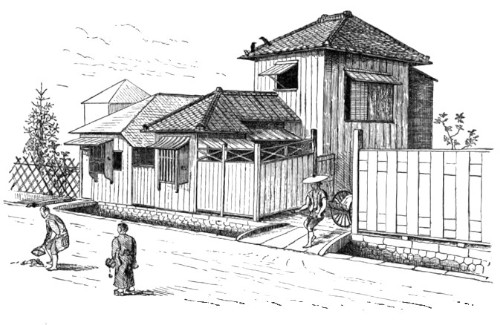 34. STREET IN KANDA KU, TOKIO It is not often that the streets are bordered by such well-constructed ditches on the side, as is represented in the last two figures; in these cases the ditches are three or four feet wide, with well-built stone-walls and stone or wooden bridges spanning them at the doors and gateways. Through these ditches the water is running, and though vitiated by the water from the kitchen and baths is yet sufficiently pure to support quite a number of creatures, such as snails, frogs, and even fishes. In the older city dwellings of the poorer classes a number of tenements often occur in a block, and the entrance is by means of a gateway common to all. Since the revolution of 1868 there has appeared a new style of building in Tokio, in which a continuous row of tenements is under one roof, and each tenement has its own separate entrance directly upon the street. Fig. 35 gives a sketch of a row of these tenements. These blocks, nearly always of one story, are now quite common in various parts of Tokio. In the rear is provided a small plot for each tenement, which may be used for a garden. People of small means, but by no means the poorer classes, generally occupy these dwellings. I was informed by an old resident of Tokio that only since the revolution have houses been built with their doors or main entrances opening directly on the street. This form of house is certainly convenient and economical, and is destined to be a common feature of house-building in the future. 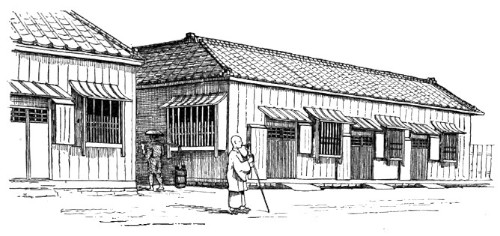 35. BLOCK OF CHEAP TENEMENTS IN TOKIO On the business streets similar rows of buildings are seen, though generally each shop is an independent building, abutting directly to the next; and in the case of all the smaller shops, and indeed of many of the larger ones, the dwelling and shop are one, the goods being displayed in the room on the street, while the family occupy the back rooms. While one is bartering at a shop, the whole front being open, he may often catch a glimpse of the family in the back room at dinner, and may look entirely through a building to a garden beyond. It is a source of amazement to a foreigner to find in the rear of a row of dull and sombre business-houses independent dwellings, with rooms of exquisite taste and cleanliness. I remember, in one of the busiest streets of Tokio, passing through a lithographer's establishment, with the inky presses and inky workmen in full activity, and coming upon the choicest of tiny gardens and, after crossing a miniature foot-bridge, to a house of rare beauty and finish. It is customary for the common merchant to live under the same roof with the shop, or in a closely contiguous building; though in Tokio, more than elsewhere, I was informed it is the custom among the wealthy merchants to have their houses in the suburbs of the city, at some distance from their place of business. 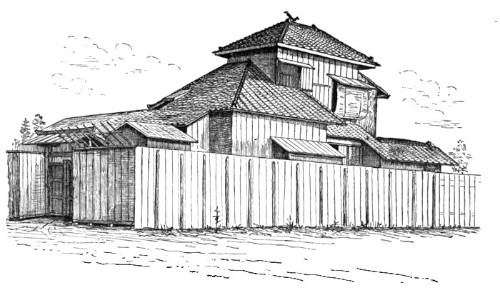 36. STREET VIEW OF DWELLING OF TOKIO The sketch shown in Fig. 36 is a city house of one of the better classes. The house stands on a new street, and the lot on one side is vacant; nevertheless, the house is surrounded on all sides by a high board-fence, since, with the open character of a Japanese house, privacy, if desired, can be secured only by high fences or thick hedges. The house is shown as it appears from the street. The front-door is near the gate, which is shown on the left of the sketch. There is here no display of an architectural front; indeed, there is no display anywhere. The largest and best rooms are in the back of the house; and what might be called a back-yard, upon which the kitchen opens, is parallel with the area in front of the main entrance to the house, and separated from it by a high fence. The second story contains one room, and this may be regarded as a guest-chamber. Access to this chamber is by means of a steep flight of steps, made out of thick plank, and unguarded by hand-rail of any kind. The roof is heavily tiled, while the walls of the house are outwardly composed of broad thin boards, put on vertically, and having strips of wood to cover the joints. A back view of this house is shown in Fig. 37. Here all the rooms open directly on the garden. Along the verandah are three rooms en suite. The balcony of the second story is covered by a light supplementary roof, from which hangs a bamboo screen to shade the room from the sun's rays. Similar screens are also seen hanging below. 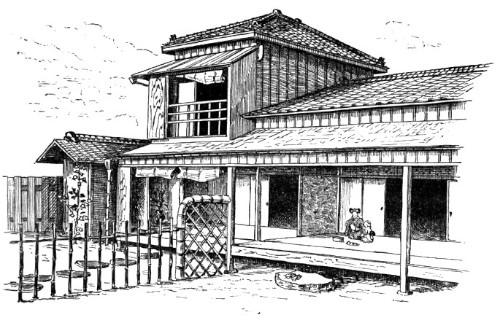 37. VIEW OF DWELLING FROM GARDEN, IN TOKIO The verandah is quite spacious; and in line with the division between the rooms is a groove for the adjustment of a wooden screen or shutter when it is desired to separate the house into two portions temporarily. At the end of the verandah to the left of the sketch is the latrine. The house is quite open beneath, and the air has free circulation. Another type of a Tokio house is shown in Fig. 38. This is a low, one-storied house, standing directly upon the street, its tiled roof cut up into curious gables. The entrance is protected by a barred sliding door. A large hanging bay-window is also barred. Just over the fence a bamboo curtain may be seen, which shades the verandah. The back of the house was open, and probably looked out on a pretty garden, though this I did not see, as this sketch, like many others, was taken somewhat hastily. 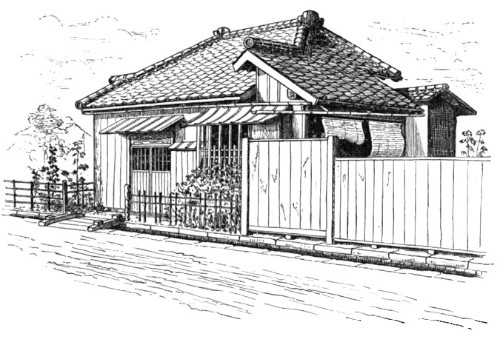 38. DWELLING NEAR KUDAN, TOKIO From this example some idea may be got of the diminutive character of many of the Japanese dwellings, in which, nevertheless, families live in all cleanliness and comfort. In the northern part of Japan houses are often seen which possess features suggestive of the picturesque architecture of Switzerland, the gable ends showing, in their exterior, massive timbers roughly hewn, with all the irregularities of the tree-trunk preserved, the interstices between these beams being filled with clay or plaster. The eaves are widely overhanging, with projecting rafters. Oftentimes delicately-carved wood is seen about the gable-ends and projecting balcony. As a still further suggestion of this resemblance, the main roof, if shingled, as well as the roof that shelters the verandah, is weighted with stones of various sizes to prevent its being blown away by the high winds that often prevail. This feature is particularly common in the Island of Yezo. 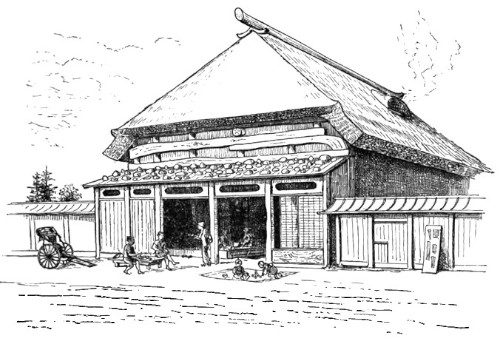 39. COUNTRY INN IN RIKUZEN Fig. 39 gives a house of this description near Matsushima, in Rikuzen. An opening for the egress of smoke occurs on the side of the roof, in shape not unlike that of a round-topped dormer window. This opening in almost every instance is found on the gable end, directly beneath the angle formed at the peak of the roof. Another house of this kind, seen in the same province, is shown in fig. 40. Here the smoke-outlet is on the ridge in the shape of an angular roof, with its ridge running at right angles to the main ridge; in this is a latticed window. This ventilator, as well as the main roof, is heavily thatched, while the supplementary ridge is of boards and weighted with stones. A good example of a heavily-tiled and plastered wooden fence is seen on the left of the sketch. In the road a number of laborers are shown in the act of moving a heavy block of stone. 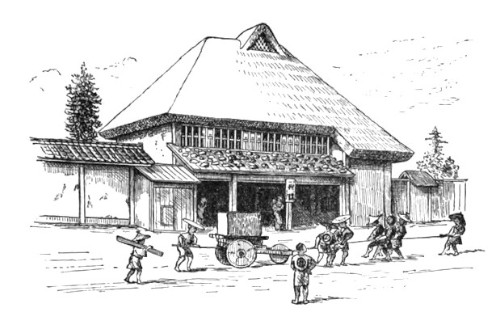 40. COUNTRY INN IN RIKUZEN Another house, shown in fig. 41, was seen on the road to Mororan, in Yezo. Here the smoke-outlet was in the form of a low supplementary structure on the ridge. The ridge itself was flat, and upon it grew a luxuriant mass of lilies. This roof was unusually large and capacious. 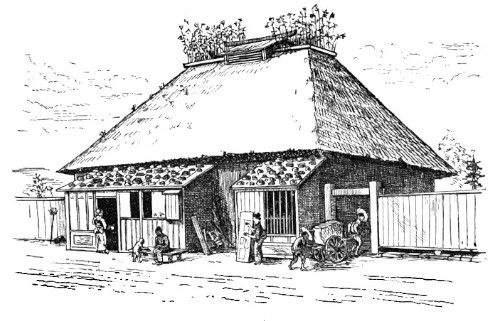 41. HOUSE NEAR MORORAN, YEZO At the place where the river Kitakami empties into the Bay of Sendai, and where we left our boat in which we had come down the river from Morioka, the houses were all of the olden style, a number of these presenting some good examples of projecting windows. Fig. 42 represents the front of a house in this place. This shows a large gable-roof, with broad overhanging eaves in front, the ends of the rafters projecting to support the eaves and the transverse-beams of the gable ends being equally in sight. The projecting window, which might perhaps be called a bay, runs nearly the entire length of the gable. The panels in the frieze were of dark wood, and bore perforated designs of pine and bamboo alternating. 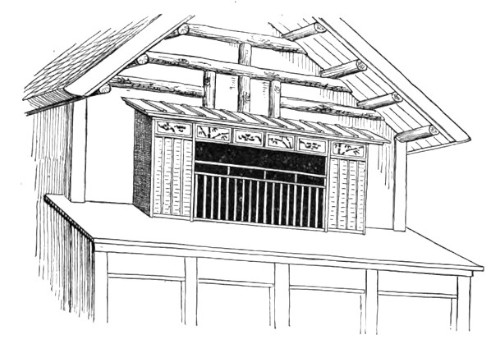 42. BAY-WINDOW, VILLAGE OF ODZUKA, RIKUZEN The larger houses of this description are always inns. They usually abut directly upon the road, and have an open appearance and an air of hospitality about them which at once indicates their character. One encounters such places so frequently in Japan, that travelling in the interior is rendered a matter of ease and comfort as compared with similar experiences in neighboring countries. The larger number of these inns in the north are of one-story, though many may be seen that are two-storied. Very rarely does a three-storied building occur. Fig. 43 represents one of this nature, that was seen in a small village north of Sendai. Houses of the better classes stand back from the road, and have bordering the road high and oftentimes ponderous ridged walls, with gateways of similar proportions and character, or fences of various kinds with rustic gateways. Long, low out buildings, for servants' quarters, also often form portions of the boundary wall. In the denser part of larger cities it is rare to find an old house, the devastating conflagrations that so often sweep across the cities rendering the survival of old houses almost an impossibility. In the suburbs of cities and in the country, however, it is not difficult to find houses one hundred, and even two or three hundred years old. The houses age as rapidly as the people, and new houses very soon turn gray from the weather; the poorer class of houses in particular appear much older than they really are. In entering Morioka, at the head of navigation on the Kitakami River, the long street presents a remarkably pretty appearance, with its odd low-roofed houses (fig. 44), each standing with its end to the street, the peak of the thatched roof overhanging the smoke-outlet like a hood. The street is bordered by a high, rustic, bamboo fence; and between the houses are little plats filled with bright-colored flowers, and shrubbery clustering within the fences, even sending its sprays into the footpath bordering the road. 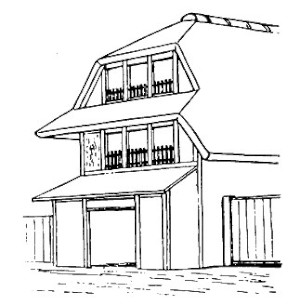 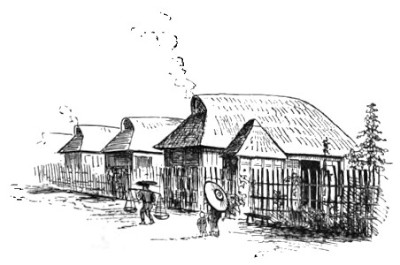 43. THREE-STORIED HOUSE OF RIKUCHIU 44. STREET IN THE SUBURBS OF MORIOKA
The country house of an independent samurai, or rich farmer, is large, roomy, and thoroughly comfortable. I recall with the keenest pleasure the delightful days enjoyed under the roof of one of these typical mansions in Kabutoyama, in the western part of the province of Musashi. The residence consisted of a group of buildings shut in from the road by a high wall. Passing through a ponderous gateway, one enters a spacious court-yard, flanked on either side by long, low buildings used as store-houses and servants' quarters. At the farther end of the yard, and facing the entrance, was a comfortable old farmhouse, having a projecting gable-wing to its right (fig. 45). The roof was a thatched one of unusual thickness. At the end of the wing was a triangular latticed opening, from which thin blue wreaths of smoke were curling. This building contained a few rooms, including an unusually spacious kitchen, a sketch of which is given farther on. The kitchen opened directly into a larger and unfinished portion of the house, having the earth for its floor, and used as a wood-shed. The owner informed me that the farm-house was nearly three hundred years old. To the left of the building was a high wooden fence, and passing through a gateway one came into a smaller yard and garden. In this area was another house quite independent of the farmhouse; this was the house for guests. Its conspicuous feature consisted of a newly-thatched roof, surmounted by an elaborate and picturesque ridge, its design derived from temple architecture. Within were two large rooms opening upon a narrow verandah. These rooms were unusually high in stud, and the mats and all the appointments were most scrupulously clean. Communication with the old house was by means of a covered passage. Back of this dwelling, and some distance from it, was still another house, two stories in height, and built in the most perfect taste; and here lived the grandfather of the family, a fine old gentleman, dignified and courtly in his manners. 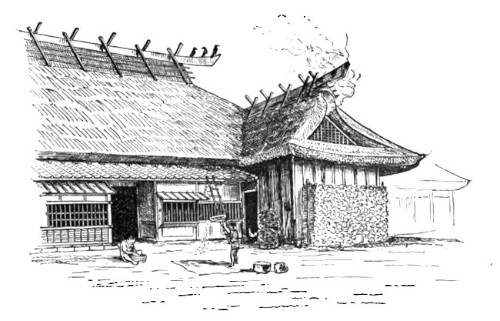 45. OLD FARM-HOUSE IN KABUTOYAMA The farm-house yard presented all the features of similar areas at home. A huge pile of wood cut for the winter's supply was piled up against the L. Basket-like coops, rakes, and the customary utensils of a farmer's occupation were scattered about. The sketch of this old house gives but a faint idea of the massive and top-heavy appearance of the roof, or of the large size of the building. The barred windows below, covered by a narrow tiled roof, were much later additions to the structure. In the city houses of the better class much care is often taken to make the surroundings appear as rural as possible, by putting here and there quaint old wells, primitive and rustic arbors, fences, and gateways. The gateways receive special attention in this way, and the oddest of entrances are often seen in thickly-settled parts of large cities. Houses with thatched roofs, belonging to the wealthiest classes, are frequently seen in the suburbs of Tokio and Kioto, and, strange as it may appear, even within the city proper. One might be led to suppose that such roofs would quickly fall a prey to the sparks of a conflagration; but an old thatched roof gets compacted with dust and soot to such an extent that plants and weeds of various kinds, and large clumps of mosses, are often seen flourishing in luxuriance upon such surfaces, offering a good protection against flying sparks. In Kioto we recall a house of this description which was nearly three centuries old; and since we made sketches of its appearance from the street, from just within the gateway, and from the rear, we will describe these views in sequence. The first view, then (fig. 46), is from the street, and represents a heavily-roofed gateway, with a smaller gateway at the side. The big gates had been removed, and the little gateway was permanently closed. This ponderous structure was flanked on one side by a low stretch of buildings, plastered on the outside, having small barred windows on the street, and a barred look-out commanding the gateway both outside and within. On the other side of the gateway was a high, thick wall, also furnished with a window or lookout. The outer walls rose directly from the wall forming the gutter, or, more properly speaking, a diminutive moat that ran along the side of the street. Blocks of worked stone formed a bridge across this moat, by which access was gained to the enclosure. The old dwelling, with its sharp-ridged roof, may be seen above the buildings just described. 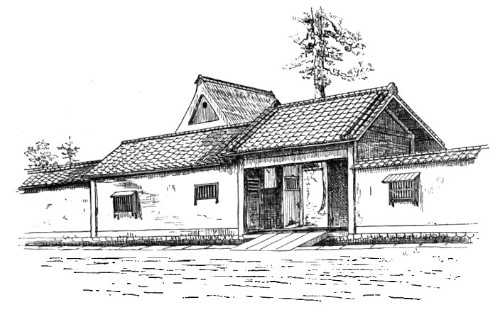 46. ENTRANCE TO COURT-YARD OF OLD HOUSE IN KIOTO Fig. 47 represents the appearance of this old house from just within the gateway. The barred window to the left of the sketch may be seen through the open gateway in fig. 46, and the tree which showed over the top of the gateway in that sketch is now in full view. The old house has a thatched roof with a remarkably steep pitch, surmounted by a ridge of tiles; a narrow tiled roof runs about the house directly below the eaves of the thatched roof. Suspended below this roof is seen a ladder and fire-engine, to be ready in case of emergency. The truth must be told, however, that these domestic engines are never ready; for when they are wanted, it is found that the square cylinders are so warped and cracked by the hot summers that when they are brought into action their chief accomplishment consists in squirting water through numerous crevices upon the men who are frantically endeavoring to make these engines do their duty properly. 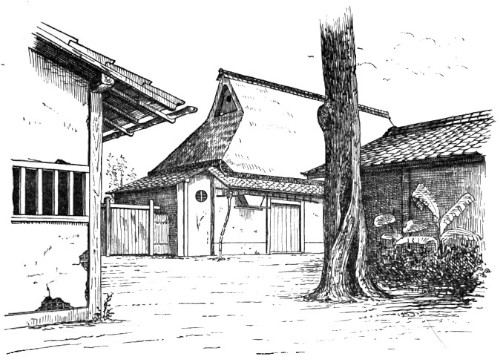 47. OLD HOUSE IN KIOTO. COURT-YARD VIEW The yard was well swept, and quite free from weeds, though at one side a number of shrubs and a banana tree were growing in a luxuriant tangle. A single tree, of considerable age, rose directly in a line with the entrance to the yard. The house, like all such houses, had its uninteresting end toward the street; and here, attached to the house, was a "lean-to," or shed, with a small circular window. This was probably a kitchen, as a gateway is seen in the sketch, which led to the kitchen-garden. In Fig. 48 a sketch of this house is given from the garden in the rear. The house is quite open behind, and looks out on the garden and fish-pond, which is seen in the foreground. The tiled roof which covers the verandah, and the out-buildings as well, was a subsequent addition to the old house. The sole occupants consisted of the mother and maiden sister of the famous antiquarian Ninagawa Noritani. The garden, with its shrubs, plats of flowers, stepping-stones leading to the fish-pond filled with lotus and lilies, and the bamboo trellis, is a good specimen of an old garden upon which but little care has been bestowed. 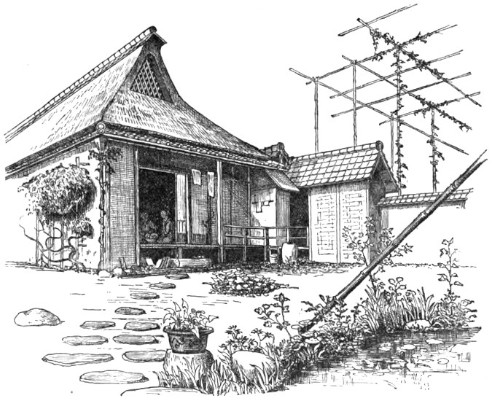 48. OLD HOUSE IN KIOTO. GARDEN VIEW In the cities nothing is more surprising to a foreigner than to go from the dust and turmoil of a busy street directly into a rustic yard and the felicity of quiet country life. On one of the busy streets of Tokio I had often passed a low shop, the barred front of which was never opened to traffic, nor was there ever any one present with whom to deal. I used often to peer between the bars; and from the form of the wooden boxes on the step-like shelves within, I knew that the occupant was a dealer in old pottery. One day I called through the bars several times, and finally a man pushed back the screen in the rear of the shop and bade me come in by way of a narrow alley a little way up the street. This I did, and soon came to a gate that led me into one of the neatest and cleanest little gardens it is possible to imagine. The man was evidently just getting ready for a tea-party, and, as is customary in winter, the garden had been liberally strewn with pine-needles, which had then been neatly swept from the few paths and formed in thick mats around some of the shrubs and trees. The master had already accosted me from the verandah, and after bringing the customary hibachi, over which I warmed my hands, and tea and cake, he brought forth some rare old pottery. The verandah and a portion of this house as it appeared from the garden are given in fig. 49. At the end of the verandah is seen a narrow partition, made out of the planks of an old ship; it is secured to the side of the house by a huge piece of bamboo. One is greatly interested to see how curiously, and oftentimes artistically, the old worm-eaten and blackened fragments of a shipwreck are worked into the various parts of a house, this being an odd fancy of the Japanese house-builder. Huge and irregular-shaped logs will often form the cross-piece to a gateway; rudder-posts fixed in the ground form the support of bronze or pottery vessels to hold water. But fragments of a shipwreck are most commonly seen. This wood is always rich in color, and has an antique appearance, these qualities commending it at once to the Japanese eye, and rendering it, with its associations, an attractive object for their purposes. 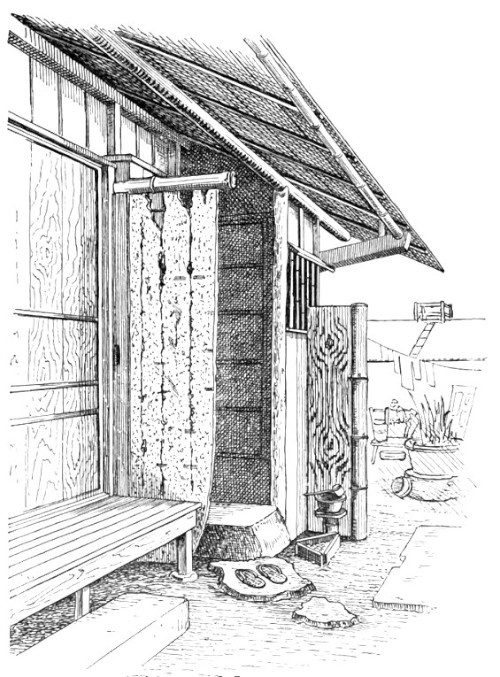 49. HOUSE IN TOKIO In the house above mentioned a portion of a vessel's side or bottom had been used bodily for a screen at the end of the verandah, for just beyond was the latrine, from the side of which is seen jutting another wing, consisting of a single weather-worn plank bordered by a bamboo-post. This was a screen to shut out the kitchen-yard beyond. Various stepping-stones of irregular shape, as well as blackened planks, were arranged around the yard in picturesque disorder. The sketch conveys, with more or less accuracy, one of the many phases of Japanese taste in these matters. The wood-work from the rafters of the verandah roof above, to the planks below, was undefiled by oil, paint, wood-filling, or varnish of any kind. The carpentry was light, yet durable and thoroughly constructive; while outside and inside every feature was as neat and clean as a cabinet. The room bordering this verandah is shown in fig. 125. Fig. 50 gives a view from the L of a gentleman's house in Tokio, from which was seen the houses and gardens of the neighborhood. The high and close fence borders a roadway which runs along the bank of the Sumida-gawa. A short fence of brush juts out obliquely from the latrine, and forms a screen between the house and the little gate. From this sketch some idea may be formed of the appearance of the balcony and verandah, and how well they are protected by the overhanging roofs. 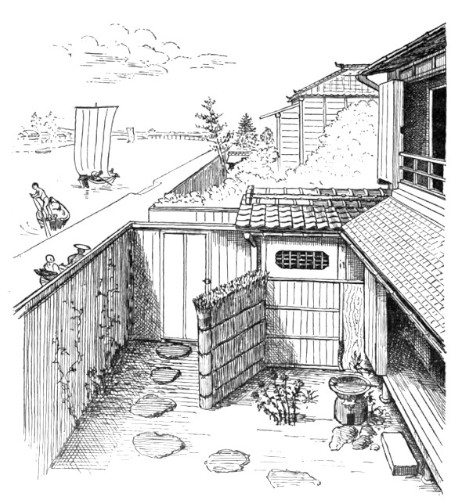 50. VIEW FROM SECOND STORY OF DWELLING IN IMADO, TOKIO The inns, particularly the country inns, have a most cosey and comfortable air about them. One always has the freedom of the entire place; at least a foreigner generally makes himself at home everywhere about the public houses, and in this respect must impress a Japanese with his boorish ways, since the native guests usually keep to their own rooms. The big, capacious kitchen, with its smoke-blackened rafters overhead, its ruddy glow of wood-fire (a sight rarely seen in the cities, where charcoal is the principal fuel), and the family busy with their various domestic duties, is a most cosey and agreeable region. On the ride across Yezo, from Otarunai to Mororan, one passes a number of inns of the most ample proportions; and their present deserted appearance contrasts strangely with their former grandeur, when the Daimio of the province, accompanied by swarms of samurai and other attendants, made his annual pilgrimage to the capital. At Mishima, in the province of Suruga, a curious old inn was seen (fig. 51). The second story overhung the first story in front, and the eaves were very widely-projecting. At the sides of the building a conspicuous feature was the verge boards, which were very large, with their lower margins cut in curious sweeps. This may have been intended for an architectural adornment, or possibly for a wind or sun screen; at all events it was, as we saw it, associated with buildings of considerable antiquity. In the middle and southern provinces of Japan the feature of an overhanging second story is by no means uncommon. 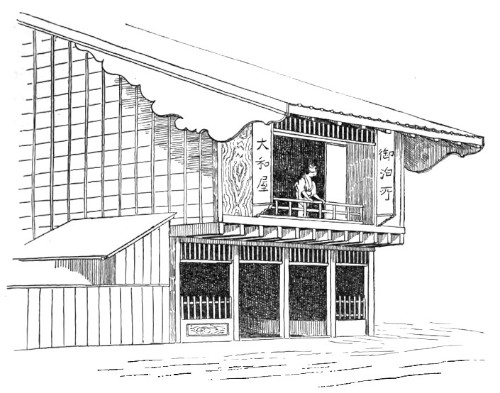 51. OLD INN IN MISHIMA, SURUGA A group of houses in a village street is shown in fig. 52. The nearest house is a resting-place for travellers; the next is a candle-shop, where the traveller and jinrikisha man may replenish their lanterns; the third is a jinrikisha stand, and beyond this is a light board-structure of some kind. All of these are dwellings as well. This street was in the village of Nagaike, between Nara and Kioto.
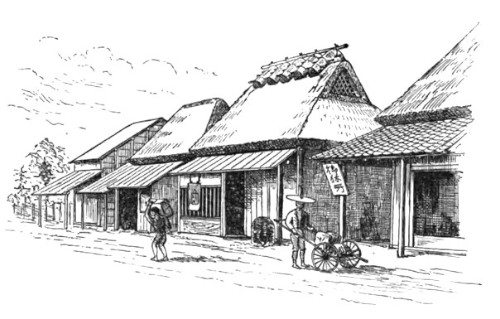 52. VILLAGE STREET IN NAGAIKE, YAMASHIRO The country houses on the east coast of Kagoshima Gulf, in the province of Osumi, as well as in the province of Satsuma, have thatched roofs of ponderous proportions, while the walls supporting them are very low. These little villages along the coast present a singular aspect, as one distinguishes only the high and thick roofs. Fig. 53 is a sketch of Mototaru-midsu as seen from the water, and fig. 54 represents the appearance of a group of houses seen in the same village, which is on the road running along the gulf coast of Osumi. The ridge is covered by a layer of bamboo; and the ends of the ridge, where it joins the hip of the roof, are guarded by a stout matting of bamboo and straw. In this sketch a regular New England well-sweep is seen, though it is by no means an uncommon object in other parts of Japan. Where the well is under cover, the well-sweep is so arranged that the well-pole goes through a hole in the roof. 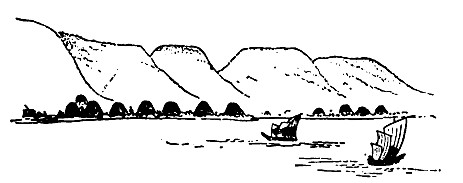 53. SHORE OF OSUMI 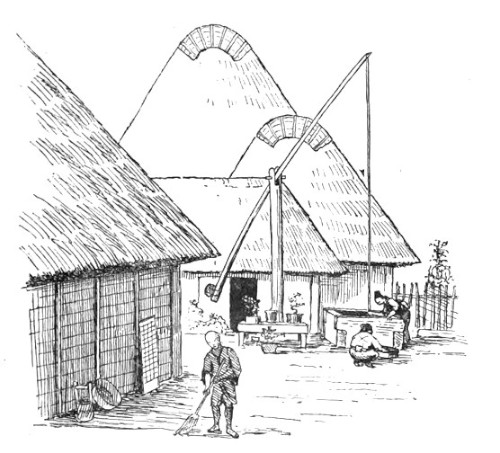 54. FARMERS' HOUSES IN MOTOTARU-MIDSU, OSUMI The fishermen's houses are oftentimes nothing more than the roughest shelters from the elements, and being more closed than the peasants' houses are consequently darker and dirtier. In the neighborhood of larger towns, where the fishermen are more prosperous, their houses compare favorably with those of the peasant class. Fig. 55 shows a group of fishermen's huts on the neck of sand which connects Hakodate with the main island. The high stockade fences act as barriers to the winds which blow so furiously across the bar at certain seasons. Fig. 56 represents a few fishermen's huts at Enoshima, a famous resort a little south of Yokohama. Here the houses are comparatively large and comfortable, though poor and dirty at best. The huge baskets seen in the sketch are used to hold and transport fish from the boat to the shore. 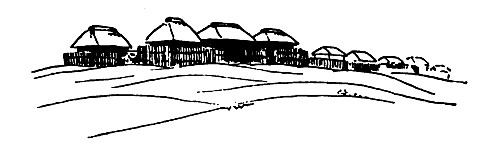 55. FISHERMEN'S HUTS IN HAKODATE 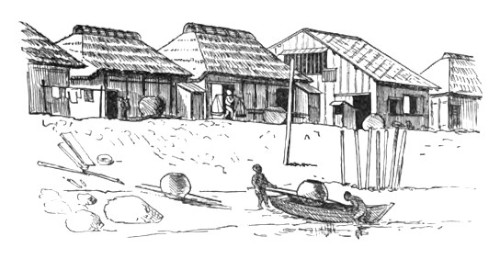 56. FISHERMEN'S HOUSES AT ENOSHIMA In the city no outbuildings, such as sheds and barns, are seen. Accompanying the houses of the better class are solid, thick-walled, fire-proof buildings called kura, in which the goods and chattels are stowed away in times of danger from conflagrations. These buildings, which are known to the foreigner as "go-downs," are usually two stories in height, and have one or two small windows, and one door, closed by thick and ponderous shutters. Such a building usually stands isolated from the dwelling, and sometimes, though rarely, they are converted into domiciles of such a character is the group of buildings in Tokio represented in fig. 57, belonging to a genial antiquary, in which he has stored a rare collection of old books, manuscripts, paintings, and other antique objects. 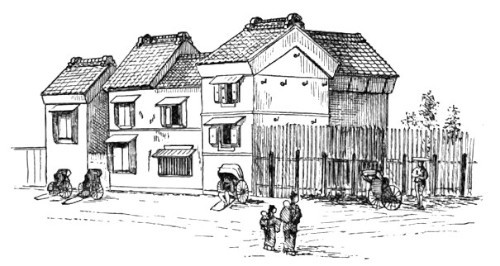 57. KURA IN TOKIO Fig. 58, copied from a sketch made by Mr. S. Koyama, represents another group of these buildings in Tokio. These kura belonged to the famous antiquarian Ninagawa Noritani. In these buildings were stored his treasures of pottery and painting. Often light wooden extensions are built around the kura, and in such cases the family live in the outside apartments. An example of this kind is shown in fig. 59, which is an old house in a poor quarter of the city of Hakodate. The central portion represents the two-storied kura, and around it is built an additional shelter having a tiled roof. In case of fire the contents of the outer rooms are hurriedly stowed within the fire-proof portion, the door closed, and the crevices chinked with mud. These buildings usually survive in the midst of a wide-spread conflagration, while all the outer wooden additions are consumed. Further reference will be made to these structures in other portions of the work. It may be proper to state, however, that nearly every shop has connected with it a fire-proof building of this nature. 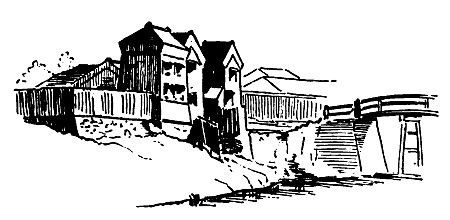 58. KURA, OR FIRE-PROOF BUILDINGS IN TOKIO (FROM SKETCH BY S. KOYAMA) 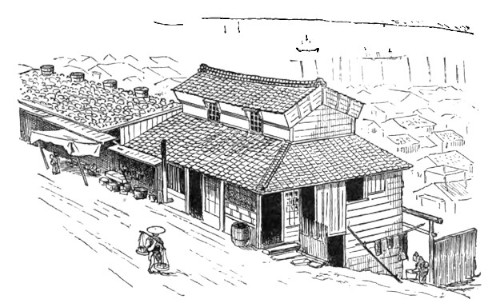 59. OLD HOUSE IN HAKODATE It hardly comes within the province of this work to describe or figure buildings which are not strictly speaking homes; for this reason no reference will be made to the monotonous rows of buildings so common in Tokio, which form portions of the boundary wall of the yashiki; and, indeed, had this been desirable, it would have been somewhat difficult to find the material, in their original condition, for study. Many of the yashikis have been destroyed by fire; others have been greatly modified, and are now occupied by various Government departments. In Tokio, for example, the yashiki of the Daimio of Kaga is used by the educational department, the Mito yashiki for the manufacture of war material, and still others are used for barracks and other Government purposes As one rides through the city he often passes these yashikis, showing from the street as long monotonous rows of buildings, generally two stories in height, with heavy tiled roofs. The wall of the first story is generally tiled or plastered. The second-story wall may be of wood or plaster. This wall is perforated at intervals with small heavily-barred windows or hanging bays. The entrance, composed of stout beams, is closed by ponderous gates thickly studded with what appear to be massive-headed bolts, but which are, however, of fictitious solidity. The buildings rest on stone foundations abutting directly on the street, or interrupted by a ditch which often assumes the dignity of a castle moat. These buildings in long stretches formed a portion of the outer walls of the yashikis within which were the separate residences of the Daimios and officers, while the buildings just alluded to were used by the soldiers for barracks.
The great elaboration and variety in the form and structure of the house-roof almost merit the dignity of a separate section. For it is mainly to the roof that the Japanese house owes its picturesque appearance; it is the roof which gives to the houses that novelty and variety which is so noticeable among them in different parts of the country. The lines of a well-made thatched roof are something quite remarkable in their proportions. A great deal of taste and skill is displayed in the proper trimming of the eaves; and the graceful way in which the eaves of the gable are made to join the side eaves is always attractive and a noticeable feature in Japanese architecture, and the admirable way in which a variety of gables are made to unite with the main roof would excite praise from the most critical architect. The elaborate structure of the thatched and tiled roofs, and the great variety in the design and structure of the ridges show what might be done by a Japanese architect if other portions of the house-exterior received an equal amount of ingenuity and attention. Japanese roofs are either shingled, thatched, or tiled. In the country, tiled roofs are the exception, the roofs being almost exclusively thatched, though in the smaller houses, especially in the larger country villages, the shingled and tiled roofs are often seen. In the larger towns and cities the houses are usually tiled; yet even here shingled roofs are not uncommon, and though cheaper than the tiled roofs, are by no means confined to the poorer houses. In the suburbs, and even in the outskirts of the cities, thatched roofs are common: in such cases the thatched roof indicates either the presence of what was at one time an old farm-house to which the city has extended, or else it is the house of a gentleman who prefers such a roof on account of its picturesqueness and the suggestions of rural life that go with it. The usual form of the roof is generally that of a hip or gable. In the thatched roof, the portion coming directly below the ridge-pole is in the form of a gable, and this blends into a hip-roof. A curb-roof is never seen. Among the poorer classes a simple pent roof is common; and additions or attachments to the main building are generally covered with a pent roof. A light, narrow, supplementary roof is often seen projecting just below the eaves of the main roof; it is generally made of wide thin boards (fig. 60). This roof is called hisashi. It commonly shelters from the sun and rain an open portion of the house or a verandah. It is either supported by uprights from the ground, or by slender brackets which are framed at right angles to the main uprights of the building proper. Weak and even flimsy as this structure often appears to be, it manages to support itself, in violation of all known laws of structure and gravitation. After a heavy fall of damp snow one may see thick accumulations covering these slight roofs, and yet a ride through the city reveals no evidences of their breaking down. One recalls similar structures at home yielding under like pressure, and wonders whether gravitation behaves differently in this land of anomalies. 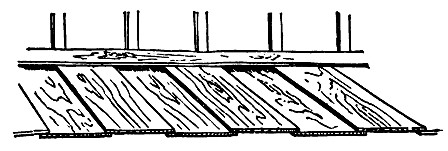 60. HISASHI In the ordinary shingled roof a light boarding is first nailed to the rafters, and upon this the shingles are secured in close courses. The shingles are always split, and are very thin, being about the thickness of an ordinary octavo book-cover, and not much larger in size, and having the same thickness throughout. They come in square bunches (fig. 61, A), each bunch containing about two hundred and twenty shingles, and costing about forty cents. 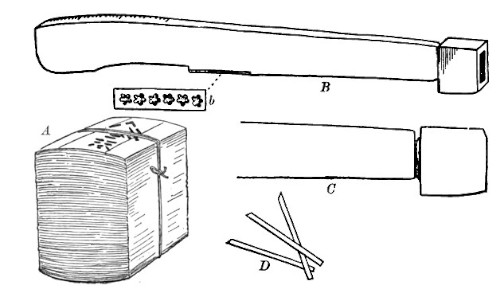 61. BUNCH OF SHINGLES, NAILS, AND HAMMER Bamboo pins, resembling attenuated shoe-pegs, are used as shingle-nails. The shingler takes a mouthful of these pegs, and with quick motions works precisely and in the same rapid manner as a similar class of workmen do at home. The shingler's hammer is a curious implement (fig. 61, B, C). The iron portion is in the shape of a square block, with its roughened face nearly on a level with its handle. Near the end of the handle, and below, is inserted an indented strip of brass (fig. 61, b). The shingler in grasping the handle brings the thumb and fore finger opposite the strip of brass; he takes a peg from his mouth with the same hand with which he holds the hammer. and with the thumb and forefinger holding the peg against the brass strip (fig. 62), he forces it into the shingle by a pushing blow. By this movement the peg is forced half-way down; an oblique blow is then given it with the hammer-head, which bends the protruding portion of the peg against the shingle, this broken down portion representing the head of our shingle-nail. The bamboo being tough and fibrous can easily be broken down without separating. In this way is the shingle held to the roof. The hammer-handle has marked upon it the smaller divisions of a carpenter's measure, so that the courses of shingles may be properly aligned. The work is done very rapidly, for with one hand the shingle is adjusted, while the other hand is busily driving the pegs. 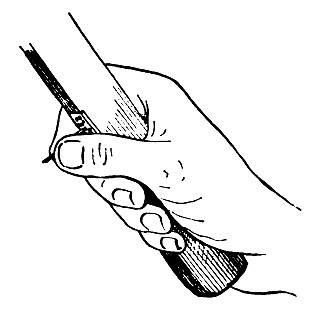 62. SHINGLER'S HAND That the shingles are not always held firmly to the roof by this method of shingling is seen in the fact that oftentimes long narrow strips of bamboo are nailed obliquely across the roof, from the ridge-pole to the eaves (fig. 63). These strips are placed at the distance of eighteen inches or two feet apart. Yet even in spite of this added precaution, in violent gales the roof is often rapidly denuded of its shingles, which fill the air at such times like autumn leaves. 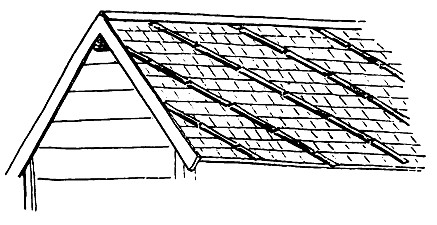 63. BAMBOO STRIPS ON SHINGLE-ROOF Fig. 64, A, represents a portion of a shingled roof with courses of shingles partially laid, and a shingler's nail-box held to the roof. The box has two compartments, the larger compartment holding the bamboo pegs; and the smaller containing iron nails, used for nailing down the boards and for other purposes. There are other methods of shingling, in which the courses of shingles are laid very closely together, and also in many layers. Remarkable examples of this method may be seen in some of the temple roofs, and particularly in the roofs of certain temple gateways in Kioto, where layers of the thinnest shingles, forming a mass a foot or more in thickness, are compactly laid, with the many graceful contours of the roof delicately preserved. The edges of the roof are beautifully rounded, and the eaves squarely and accurately trimmed. On seeing one of these-roofs, one is reminded of a thatched roof, which this style seems evidently intended to imitate. The rich brown bark of the hi-no-ki tree is also used in a similar way; and a very compact and durable roof it appears to make. In better shingled house-roofs it is customary to secure a wedge-shaped piece of wood parallel to the eaves, to which the first three or four rows of shingles are nailed; other courses of shingles are then laid on very closely, and thus a thicker layer of shingles is secured (fig. 64, B). 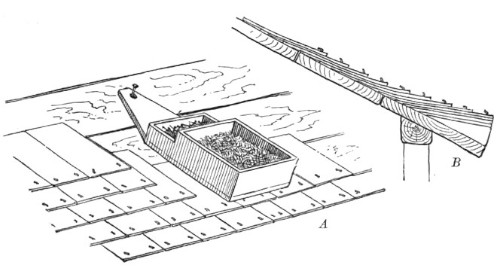 64. ROOF WITH SHINGLES PARTLY LAID But little variety of treatment of the ridge is seen in a shingled roof. Two narrow weather-strips of wood nailed over the ridge answer the purpose of a joint, as is customary in our shingled roofs. A more thorough way is to nail thin strips of wood of a uniform length directly over the ridge and at right angles to it. These strips are thin enough to bend readily. Five or six layers are fastened in this way, and then, more firmly to secure them to the roof, two long narrow strips of wood or bamboo are nailed near the two edges of this mass, parallel to the ridge (fig. 65). 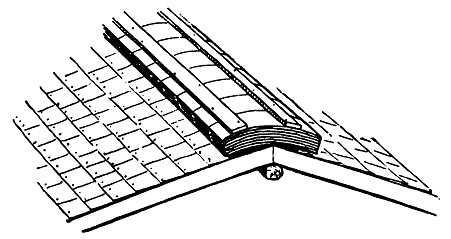 65. RIDGE OF SHINGLE-ROOF IN MUSASHI The shingled roof is the most dangerous element of house-structure in the cities. The shingles are nothing more than thick shavings, and curved and warped by the sun are ready to spring into a blaze by the contact of the first spark that falls upon them, and then to be sent flying by a high wind to scatter the fire for miles. A very stringent law should be passed, prohibiting the use of such material for roofing in cities and large villages. The usual form of gutter for conveying water from the roof consists of a large bamboo split lengthwise, with the natural partitions broken away. This is held to the eaves by iron hooks, or by long pieces of wood nailed to the rafters, their upper edges being notched, in which the bamboo rests. This leads to a conductor, consisting also of a bamboo, in which the natural partitions have likewise been broken through. The upper end of this bamboo is cut away in such a manner as to leave four long spurs; between these spurs a square and tapering tunnel of thin wood is forced, the elasticity of the bamboo holding the tunnel in place (fig. 66). 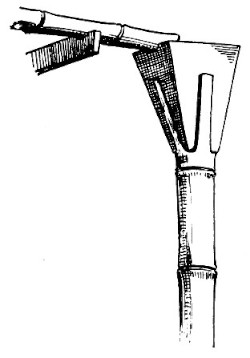 66. WATER-CONDUCTOR Attention has so often been drawn, in books of travels, to the infinite variety of ways in which Eastern nations use the bamboo, that any reference to the subject here would be superfluous. I can only say that the importance of this wonderful plant in their domestic economy has never been exaggerated. The more one studies the ethnographical peculiarities of the Japanese, as displayed in their houses, utensils, and countless other fabrications, the more fully is he persuaded that they could more easily surrender the many devices and appliances adopted from European nations, than to abandon the ubiquitous bamboo.
In tiling a roof, the boarded roof is first roughly and thinly shingled, and upon this surface is then spread a thick layer of mud, into which the tiles are firmly bedded. The mud is scooped up from some ditch or moat, and is also got from the canals. In the city one often sees men getting the mud for this purpose from the deep gutters which border many of the streets. This is kneaded and worked with hoe and spade till it acquires the consistency of thick dough. In conveying this mass to the roof no hod is used. The material is worked into large lumps by the laborer, and these are tossed, one after another, to a man who stands on a staging or ladder, who in turn pitches it to the man on the roof, or, if the roof be high, to another man on a still higher staging. The mud having been got to the roof, is then spread over it in a thick and even layer. Into this the tiles are then bedded, row after row. There seems to be no special adhesion of the tiles to this substratum of mud, and high gales often cause great havoc to a roof of this nature. In the case of a conflagration, when it becomes necessary to tear down buildings in its path, the firemen appear to have no difficulty in shovelling the tiles off a roof with ease and rapidity. The ridge-pole often presents an imposing combination of tiles and plaster piled up in square ridges and in many ornamental ways. In a hip-roof the four ridges are also made thick and ponderous by successive layers of tiles being built up, and forming great square ribs. In large fire-proof buildings the ridge may be carried up to a height of three or four feet. In such ridges white plaster is freely used, not only as a cement, but as a medium in which the artist works out various designs in high-relief. One of the most favorite subjects selected is that of dashing and foaming waves. A great deal of art and skill is often displayed in the working out of this design, which is generally very conventional, though at times great freedom of expression is shown in the work. It certainly seems an extraordinary design for the crest of a roof, though giving a very light and buoyant appearance to what would otherwise appear top-heavy. Fig. 67 is a very poor sketch of the appearance of this kind of a ridge. From the common occurrence of this design, it would seem as if some sentiment or superstition led to using this watery subject as suggesting a protection from fire; whether this be so or not, one may often notice at the end of the ridge in the thatched roofs in the country the Chinese character for water deeply cut in the straw and blackened (fig. 82), and this custom, I was told, originated in a superstition that the character for water afforded a protection against fire. 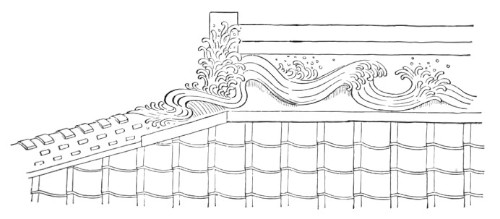 67. RIDGE OF TILED ROOF The tiled ridges always terminate in a shouldered mass of tiles specially designed for the purpose. The smaller ribs of tiles that run down to the eaves, along the ridges in a hip-roof, or border the verge in a gable-roof, often terminate .in some ornamental tile in high-relief. The design may be that of a mask, the head of a devil, or some such form. In the heavier ridges much ingenuity and art are shown in the arrangement of semi-cylindrical or other shaped tiles in conventional pattern. Figs. 68, 69, 70 will illustrate some of the designs made in this way. These figures, however, represent copings of walls in Yamato. 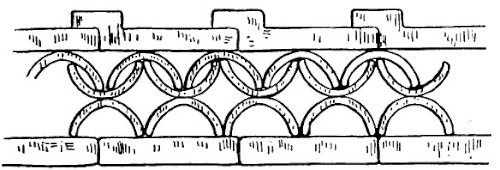 68. ORNAMENTAL COPING OF TILES  69. ORNAMENTAL COPING OF TILES  70. ORNAMENTAL COPING OF TILES Many of the heavier ridges are deceptive, the main body consisting of a frame of wood plastered over, and having the appearance externally of being a solid mass of tile and plaster The tiles that border the eaves are specially designed for the purpose. The tile has the form of the ordinary tile, but its free edge is turned down at right angles and ornamented with some conventional design. Fig. 71 illustrates this form of tile. In the long panel a design of flowers or conventional scrolls in relief is often seen. The circular portion generally contains the crest of some family: the crest of the Tokugawa family is rarely seen on tiles (see fig. 73). 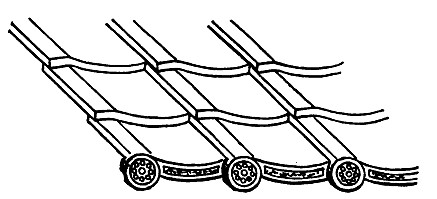 71. EAVES OF TILED ROOF
In the better class of tiled roof it is common to point off with white mortar the joints between the rows of tiles near the eaves, and also next the ridge; and oftentimes the entire roof is treated in this manner. In some photographs of Korean houses taken by Percival Lowell, Esq., the same method of closing the seams of the bordering rows of tiles with white plaster is shown. The older a tile is, the better it is considered for roofing purposes. My attention was called to this fact by a friend stating to me with some pride that the tiles used in his house, just constructed, were over forty years old. Second-hand tiles therefore are always in greater demand. A new tile, being very porous and absorbent, is not considered so good as one in which time has allowed the dust and dirt to fill the minute interstices, thus rendering it a better material for shedding water. A tiled roof cannot be very expensive, as one finds it very common in the cities and larger villages. The price of good tiles for roofing purposes is five yen for one hundred (one yen at par equals one dollar). Cheap ones can be got for from two and one-half yen to three yen for one hundred. In another measurement, a tsubo of tiles, which covers an area of six feet square, can be laid for from two and one-half to three yen. The form of tile varies in different parts of Japan. The tile in common use in Nagasaki (fig. 72, A) is similar in form to those used in China, Korea, Singapore, and Europe. These tiles are slightly curved, and are laid with their convex surface downwards. Another form of tile, narrower and semi-cylindrical in section, is laid with its convex side upwards, covering the seams between the lower rows of tiles. This is evidently the most ancient form of tile in the East, and in Japan is known by the name of hon-gawara, or true tile. Fig. 73 represents the form of the hon-gawara used in Tokio.  72. NAGASAKI TILED ROOF 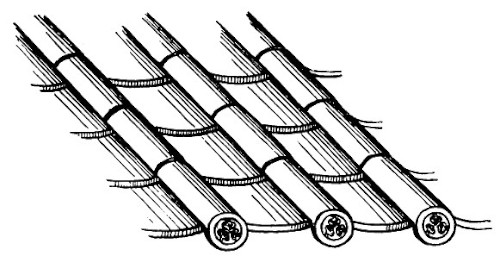 73. HON-GAWARA, OR TRUE TILE The most common form of tile used in Tokio is represented in fig. 71, called the yedo-gawara, or yedo tile. With this tile the upper convex tile is dispensed with, as the tile is constructed in such a way as to lap over the edge of the one next to it. Fig. 74 illustrates the eaves of a roof in which a yedo tile is used, having the bordering tiles differing in form from those shown in fig. 71. A modification of this form is seen farther south in Japan (fig. 72, B), and also in Java.  74. YEDO-GAWARA, OR YEDO-TILE EAVES A new form of tile, called the French tile, has been introduced into Tokio within a few years (fig. 75). It is not in common use, however; and I can recall only a few buildings roofed with this tile. These are the warehouses of the Mitsu Bishi Steamship Company near the post-office, a building back of the Art Museum at Uyeno, and a few private houses. 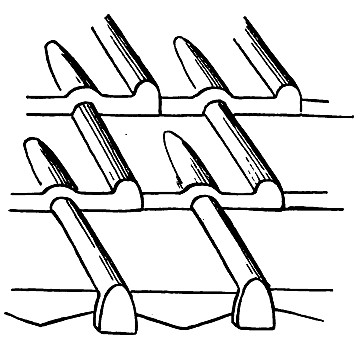 75. FRENCH-TILE EAVES Other forms of tiles are made for special purposes. In the province of Iwami, for example, a roof-shaped tile is made specially for covering the ridge of thatched roofs (fig. 76, A). The true tile is also used for the same purpose (fig. 76, B).  76. IWAMI TILE FOR RIDGE In this province the tiles are glazed, the common tiles being covered with a brown glaze, while the best tiles are glazed with iron sand. In digging the foundations for a library building at Uyeno Park, a number of large glazed tiles were dug up which were supposed to have been brought from the province of Bizen two hundred years ago. These were of the hon-gawara pattern. In the province of Shimotsuke, and doubtless in adjacent provinces, stone kura (fire-proof store-houses) are seen; and these buildings often have roofs of the same material. The stone appears to be a light-gray volcanic tufa, and is easily wrought. The slabs of stone covering the roof are wrought into definite shapes, so that the successive rows overlap and interlock in a way that gives the appearance of great solidity and strength. Fig. 77 illustrates a portion of a roof of this description seen on the road to Nikko. I was told by a Korean friend that stone roofs were also to be found in the northern part of Korea, though whether made in this form could not be ascertained. 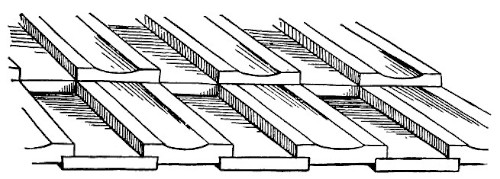 77. STONE ROOF The thatched roof is by far the most common form of roof in Japan, outside the cities. The slopes of the roof vary but little; but in the design and structure of the ridge the greatest variety of treatment is seen. South of Tokio each province seems to have its own peculiar style of ridge; at least, as the observant traveller passes from one province to another his attention is attracted by a new form of ridge, which though occasionally seen in other provinces appears to be characteristic of that particular province. This is probably due to the partially isolated life of the provinces in feudal times; for the same may be said also in regard to the pottery and many other products of the provinces. For thatching, various materials are employed. For the commonest thatching, straw is used; better kinds of thatch are made of a grass called Kaya. A kind of reed called yoshi is used for this purpose, and also certain species of rush. The roof requires no special preparation to receive the thatch, save that the rafters and frame-work shall be close enough together properly to secure and support it. If the roof be small, a bamboo frame-work is sufficient for the purpose. The thatch is formed in suitable masses, combed with the fingers and otherwise arranged so that the straws all point in the same direction. These masses are then secured to the rafters and bound down to the roof by bamboo poles (fig. 78, A), which are afterwards removed. While the thatch is bound down in this way it is beaten into place by a wooden mallet of peculiar shape (fig. 78, B). The thatch is then trimmed into shape by a pair of long-handled shears (fig. 78, C) similar to the shears used for trimming grass in our country. 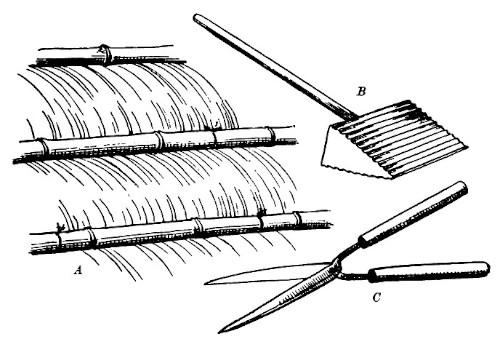 78. THATCH AND THATCHERS' IMPLEMENTS This is only the barest outline of the process of thatching; there are doubtless many other processes which I did not see. Suffice it to say, however, that when a roof is finished it presents a clean, trim, and symmetrical appearance, which seems surprising when the nature of the material is considered. The eaves are trimmed off square or slightly rounding, and are often very thick, being sometimes two feet or more in thickness. This does not indicate, however, that the thatch is of the same thickness throughout. The thatch trimmed in these various ways is thus seen in section, and one will often notice at this section successive layers of light and dark thatch. Whether it is old thatch worked in with the new for the sake of economy, or different kinds of thatching material, I did not ascertain. In old roofs the thatch becomes densely filled with soot and dust, and workmen engaged in repairing such roofs have the appearance of coal-heavers. While a good deal of skill and patience is required to thatch a roof evenly and properly, vastly more skill must be required to finish the ridge, which is often very intricate in its structure; and of these peculiar ridges there are a number of prominent types. In presenting these types, more reliance will be placed on the sketches to convey a general idea of their appearance than on descriptions. In that portion of Japan lying north of Tokio the ridge is much more simple in its construction than are those found in the southern part of the Empire. The roofs are larger, but their ridges, with some exceptions, do not show the artistic features, or that variety in form and appearance, that one sees in the ridges of the southern thatched roof. In many cases the ridge is flat, and this area is made to support a luxuriant growth of iris, or the red lily (fig. 41). A most striking feature is often seen in the appearance of a brown sombre-colored village, wherein all the ridges are aflame with the bright-red blossoms of the lily; or farther south, near Tokio, where the purer colors of the blue and white iris form floral crests of exceeding beauty. In some cases veritable ridge-poles, with their ends freely projecting beyond the gable and wrought in a gentle upward curve, are seen (fig. 39). This treatment of the free ends of beams in ridge-poles, gateways, and other structures, notably in certain forms of tori-i,1 is a common feature in Japanese architecture, and is effective in giving a light and buoyant appearance to what might otherwise appear heavy and commonplace. At Fujita, in Iwaki, and other places in that region, a roof is often seen which shows the end of a round ridge-pole projecting through the thatch at the gable-peak; and at this point a flat spur of wood springs up from the ridge, to which is attached, at right angles, a structure made of plank and painted black, which projects two feet or more beyond the gable. This appears to be a survival of an exterior ridge-pole, and is retained from custom. Its appearance, however, is decidedly flimsy and insecure, and from its weak mode of attachment it must be at the mercy of every high gale (fig. 79). After getting south of Sendai, ridges composed of tile are often to be seen, becoming more common as one approaches Tokio. The construction of this kind of ridge is very simple and effective; semi-cylindrical tiles, or the wider forms of hon-gawara, are used for the crest, and these in turn cap a row of similar tiles placed on either side of the ridge (fig. 80). The tiles appear to be bedded in a layer of clay or mud and chopped straw, which is first piled on to the thatched ridge. In some cases a large bamboo holds the lower row of tiles in place (fig. 81). What other means there are of holding the tiles I did not learn. They must be fairly secure, however, as it is rare to see them displaced, even in old roofs. 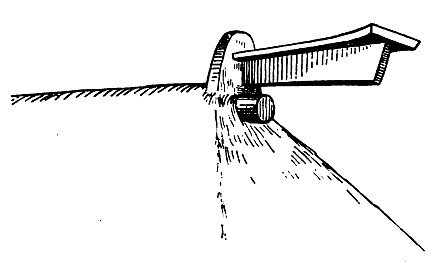 79. END OF ROOF IN FUJITA, IWAKI 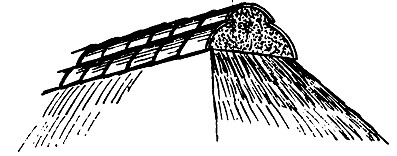 80. TILED RIDGE OF THATCHED ROOF IN IWAKI 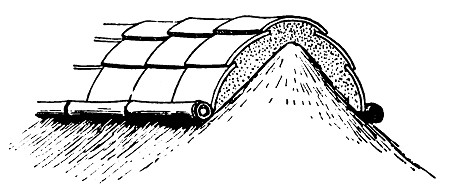 81. TILED RIDGE OF THATCHED ROOF IN MUSASHI A very neat and durable ridge (fig. 82) is common in Musashi and neighboring provinces. This ridge is widely rounded. It is first covered with a layer of small bamboos; then narrow bands of bamboo or bark are bent over the ridge at short intervals, and these are kept in place by long bamboo-strips or entire bamboos, which run at intervals parallel to the ridge. These are firmly bound down to the thatch. In some cases these outer bamboos form a continuous layer. The ends of the ridge, showing a mass of projecting thatch in section, are abruptly cut vertically, and the free border is rounded in a bead-like moulding and closely bound by bamboo, appearing like the edge of a thick basket. This finish is done in the most thorough and workman-like manner. It is upon the truncate end of this kind of a ridge that the Chinese character for water is often seen, allusion to which has already been made. 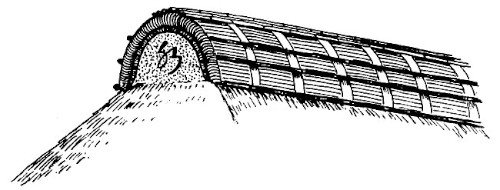 82. BAMBOO RIDGE OF THATCHED ROOF IN MUSASHI When there is no window at the end of the roof for the egress of smoke, the roof comes under the class of hip-roofs. In the northern provinces the opening for the smoke is built in various ways upon the ridge or side of the roof. By referring to figs. 39, 40, 41, various methods of providing for this window may be seen. Smoke-outlets do occur at the ends of the roof in the north, as may be seen by referring to fig. 44. The triangular opening for the outlet of smoke is a characteristic feature of the thatched roofs south of Tokio; on some of them a great deal of study and skill is bestowed by the architect and builder. Sometimes an additional gable is seen, with its triangular window (fig. 83). This sketch represents the roof of a gentleman's house near Tokio, and is a most beautiful example of the best form of thatched roof in Musashi. Another grand old roof of a different type is shown in fig. 84. Where these triangular windows occur the opening is protected by a lattice of wood. The roof partakes of the double nature of a gable and hip-roof combined the window being in the gable part, from the base of which runs the slope of the hip-roof. 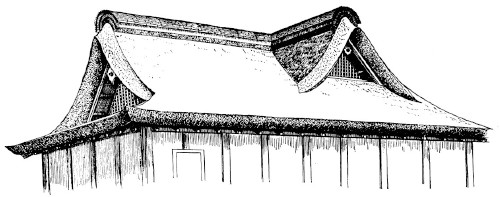 83. THATCHED ROOF, NEAR TOKIO Great attention is given to the proper and symmetrical trimming of the thatch at the eaves and at the edges of the gable. By referring to figs. 83 and 84 some idea may be got of the clever way in which this is managed. Oftentimes, at the peak of the gable, a cone-like enlargement with a circular depression is curiously shaped out of the thatch (fig. 84). A good deal of skill is also shown in bringing the thick edges of the eaves, which are on different levels, together in graceful curves. An example of this kind may be seen in fig. 39. 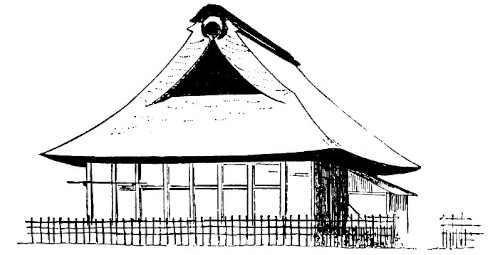 84. THATCHED ROOF, NEAR TOKIO 2 (FROM PHOTOGRAPH TAKEN BY PERCIVAL LOWELL, ESQ.) In Musashi a not uncommon form of ridge is seen, in which there is an external ridge-pole wrought like the upper transverse beam of a tori-i. This beam has a vertical thickness of twice or three times its width; resting transversely upon it, and at short intervals, are a number of wooden structures shaped like the letter X, the lower ends of these pieces resting on the slopes of the roof, the upper ends projecting above the ridgepole. The ridge at this point is matted with bark; and running parallel with the ridge a few bamboos are fastened, upon which these cross-beams rest, and to which they are secured (fig. 45). Modifications of this form of ridge occur in a number of southern provinces, and ridges very similar to this I saw in Saigon and Cholon, in Anam. The curious Shin-to temple, at Kamijiyama, in Ise, said to be modelled after very ancient types of roof, has the end-rafters of the gable continuing through the roof and beyond the peak to a considerable distance. It was interesting to see precisely the same features in same of the Malay houses in the neighborhood of Singapore. In Musashi, and farther south, a ridge is seen of very complex structure, the entire ridge forming a kind of supplementary roof, its edges thick and squarely trimmed, and presenting the appearance of a smaller roof having been made independently and dropped upon the large roof like a saddle. This style of roof, with many modifications, is very common in Yamashiro, Mikawa, and neighboring provinces. A very elaborate roof of this description is shown in fig. 85. This roof was sketched in Kabutoyama, a village nearly fifty miles west of Tokio. In this ridge the appearance of a supplementary roof is rendered more apparent by the projection beneath of what appears to be a ridge-pole, and also parallel sticks of the roof proper. This roof had a remarkably picturesque and substantial appearance. This style of roof is derived from temple architecture. 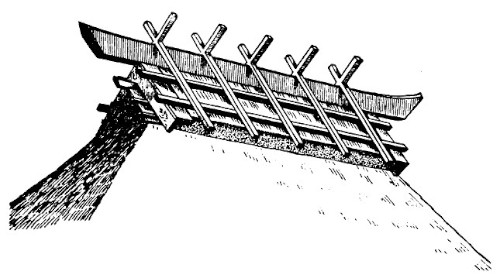 85. RIDGE OF THATCHED ROOF AT KABUTOYAMA, MUSASHI A very simple form of ridge is common in the province of Omi; this is made of thin pieces of board, three feet or more in length, secured on each slope of the roof and at right angles to the ridge; and these are bound down by long strips of wood, two resting across the ridge, and another strip resting on the lower edge of the boards (fig. 86). In the provinces of Omi and Owari tiled ridges are often seen, and some ridges in which wood and tile are combined. At Takatsuki-mura, in Setsu, a curious ridge prevails. The ridge is very steep, and is covered by a close mat of bamboo, with saddles of tiles placed at intervals along the ridge (fig. 87). A very picturesque form of ridge occurs in the province of Mikawa; the roof is a hip-roof, with the ridge-roof having a steep slope trimmed off squarely at the eaves. On this portion strips of brown bark are placed across the ridge, resting on the slopes of the roof; a number of bamboos rest on the bark, parallel to the ridge; on the top of these, stout, semi-cylindrical saddles, sometimes sheathed with bark, rest across the ridge, with an interspace of three or four feet between them. Fig. 88 represents a roof with three of these saddles, which is the usual number. These saddles are firmly bound to the roof, and on their crests and directly over the ridge a long bamboo is secured by a black-fibred cord, which is tied to the ridge between each saddle. The smoke-outlet at the end of the ridge-gable is protected by a mass of straw hanging down from the apex of the window, in shape and appearance very much like a Japanese straw rain-coat. The smoke filters out through this curtain, though the rain cannot beat in.  86. CREST OF THATCHED ROOF IN OMI 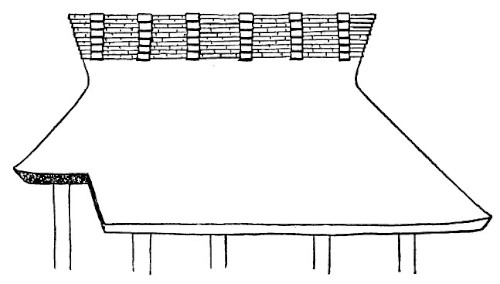 87. TILE AND BAMBOO RIDGE OF THATCHED ROOF, TAKATSUKI, SETSU Roofs of a somewhat similar construction may be seen in other provinces. In the suburbs of Kioto a form of roof and ridge, after a similar design, may be often seen. In this form the supplementary roof is more sharply defined; the corners of it are slightly turned up as in the temple-roof. To be more definite, the main roof, which is a hip-roof, has built upon it a low upper-roof, which is a gable; and upon this rests, like a separate structure, a continuous saddle of thatch, having upon its back a few bamboos running longitudinally, and across the whole a number of thick narrow saddles of thatch sheathed with bark, and over all a long bamboo bound to the ridge with cords (fig. 89). These roofs, broad and thick eaved, with their deep-set, heavily latticed smoke-windows, and the warm brown thatch, form a pleasing contrast to the thin-shingled roofs of the poorer neighboring houses. 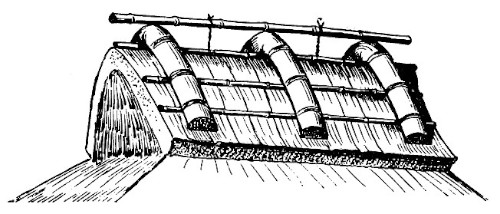 88. CREST OF THATCHED ROOF IN MIKAWA 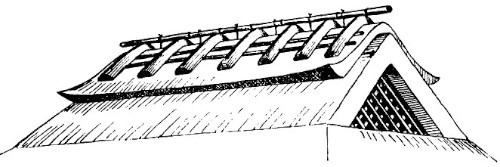 89. CREST OF THATCHED ROOF IN KIOTO Another form of Mikawa roof, very simple and plain in structure, is shown in fig. 90. Here the ridge-roof is covered with a continuous sheathing of large bamboos, with rafter-poles at the ends coming through the thatch and projecting beyond the peak. 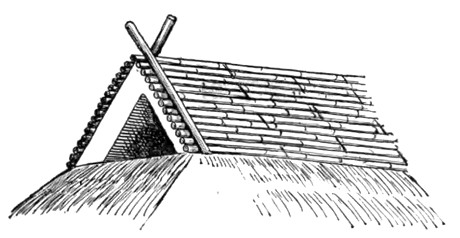 90. CREST OF THATCHED ROOF IN MIKAWA In the provinces of Kii and Yamato the forms of ridges are generally very simple. In one form, common in the province of Kii, the ridge-roof, which has a much sharper incline than the roof proper, is covered with bark, this being bound down by parallel strips, or whole rods of bamboo; and spanning the ridge at intervals are straw saddles sheathed with bark. These are very narrow at the ridge, but widen at their extremities. The smoke-outlet is a small triangular opening (fig. 91). In the province of Yamato there are two forms of roof very common. In one of these the roof is a gable, the end-walls, plastered with clay and chopped straw, projecting above the roof a foot or more, and capped with a simple row of tiles (fig. 92), the ridge in this roof being made as in the last one described. In another form of roof with a similar ridge, the thatch on the slopes of the roof is trimmed in such a way as to present the appearance of a series of thick layers, resting one upon another like shingles, only each lap being eighteen inches to two feet apart, with thick edges. It was interesting and curious to find in the ancient province of Yamato this peculiar treatment of the slopes of a thatched roof, precisely like certain roofs seen among the houses of the Ainos of Yezo. 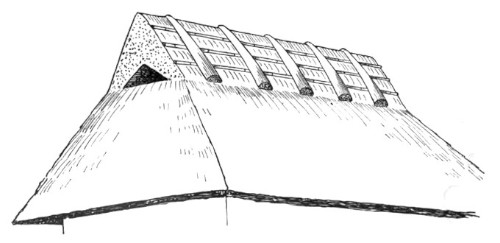 91. CREST OF THATCHED ROOF IN KII 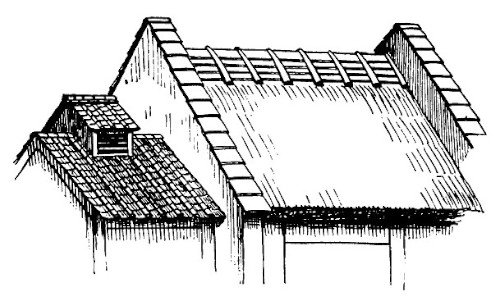 92 THATCHED ROOF IN YAMATO In the provinces of Tōtōmi and Suruga a form of ridge was observed, unlike any encountered elsewhere in Japan. The ridge-roof was large and sharply angular. Resting upon the thatch, from the ridge-pole half way down to the main roof, were bamboos placed side by side, parallel to the ridge. Upon this layer of bamboos were wide saddles of bark a foot or more in length, with an interspace of nearly two feet between each saddle, these reaching down to the main roof. On each side of the ridge-roof, and running parallel to the ridge, were large bamboo poles resting on the saddles, and bound down firmly with cords. On the sharp crest of the roof rested a long round ridge-pole. This pole was kept in place by wide bamboo slats, bent abruptly into a yoke, in shape not unlike a pair of sugar-tongs, and these spanning the pole were thrust obliquely into the thatch. These were placed in pairs and crosswise in the interspaces between the bark saddles. On the ends of the ridge there were two bamboo yokes together. The sketch of this roof (fig. 93) will give a much clearer idea of its appearance and structure than any description. This style of roof was unique, and appeared to be very strong and durable. 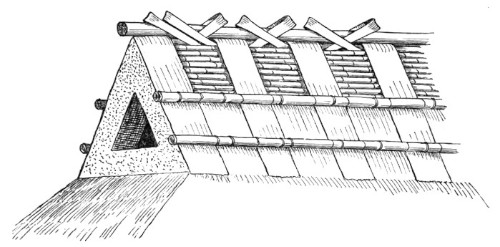 93. CREST OF THATCHED ROOF IN TŌTŌMI In the province of Ise a simple type of roof was seen (fig. 94). The ridge-roof was quite low, sheathed with bark and bound down with a number of bamboos. At the gable were round masses of thatch covered with bark, which formed an ornamental moulding at the verge.3  94. CREST OF THATCHED ROOF IN ISE In the province of Osumi, on the eastern side of Kagoshima Gulf, the vertical walls of the buildings are very low; but these support thatched roofs of ponderous proportions. These roofs are somewhat steeper than the northern roof, and their ridges are wide and bluntly rounded. The ends of the ridge are finished with a wide matting of bamboo, and this material is used in binding down the ridge itself (fig. 54). There are doubtless many other forms of thatched roof, but it is believed that the examples given present the leading types. As one becomes familiar with the picturesqueness and diversity in the Japanese roof and ridge, he wonders why the architects of our own country have not seen fit to extend their taste and ingenuity to the roof, as well as to the sides of the house. There is no reason why the ridge of an ordinary wooden house should invariably be composed of two narrow weather-strips, or why the roof itself should always be stiff, straight, and angular. Certainly our rigorous climate can be no excuse for this, for on the upper St. John, and in the northern part of Maine, one sees the wooden houses of the French Canadians having roofs widely projecting, with the eaves gracefully turning upward, presenting a much prettier appearance than does the stiff angular roof of the New England house. It is indeed a matter of wonder that some one in building a house in this country does not revert to a thatched roof. Our architectural history shows an infinite number of reversions, and if a thatched roof were again brought into vogue, a new charm would be added to our landscape. The thatched roof is picturesque and warm, and makes a good rain-shed. In Japan an ordinary thatched roof will remain in good condition from fifteen to twenty years; and I have been told that the best kinds of thatched roof will endure for fifty years, though this seems incredible. As they get weather-worn they are often patched and repaired, and finally have to be entirely renewed. Old roofs become filled with dust, assume a dark color, and get matted down; plants, weeds, and mosses of various kinds grow upon them, as well as masses of gray lichen. When properly constructed they shed water very promptly, and do not get water-soaked, as one might suppose. It is customary in the better class of houses having thatched roofs to pave the ground with small cobble-stones, for a breadth of two feet or more immediately below the eaves, to catch the drip, as in a thatched roof it is difficult to adjust any sort of a gutter or water-conductor. Fig. 95 illustrates the appearance of the paved space about a house, the roof of which is shown in fig. 85. 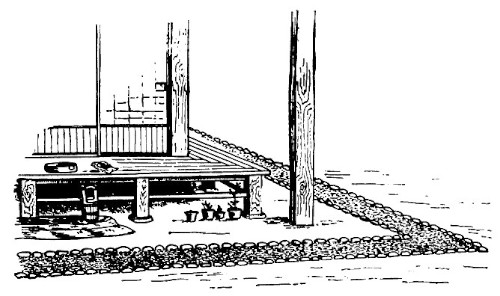 95. PAVED SPACE UNDER EAVES OF THATCHED ROOF The translation of the terms applied to many parts of the house is quite curious and interesting. The word mune, signifying the ridge of the house, has the same meaning as with us; the same word is applied to the back of a sword and to the ridge of a mountain. In Korea the ridge of the thatched roof is braided, or at least the thatch seems to be knotted or braided at this point; and the Korean word for the ridge means literally back-bone, from its resemblance to the back-bone of a fish. In Japan the roof of a house is called yane. Now, yane literally means house-root; but how such a term could be applied to the roof is a mystery. I have questioned many intelligent Japanese in regard to this word, and have never received any satisfactory answer as to the reason of its application to the roof of a house. A Korean friend has suggested that the name might have been applied through association: a tree without a root dies, and a house without a roof decays. He also told me that the Chinese character ne meant origin. In Korea the foundation of a house is called the foot of the house, and the foundation stones are called shoe-stones. The Japanese word for ceiling is ten-jō, literally, "heaven's well." It is an interesting fact that the root of both words, ceiling and ten-jō, means "heaven." __________________________ 1 A structure of stone or wood, not unlike the naked frame-work of a gate, erected in front of shrines and temples. 2 This sketch was made from a photograph taken for this work, at the suggestion of Dr. W. S. Bigelow, by Percival Lowell, Esq. 3 We have characterized as a ridge-roof that portion which has truncate ends, in other words, the form of a gable, and which receives special methods of treatment. The line of demarcation between the long reach of thatch of the roof proper and the ridge-roof is very distinct. |